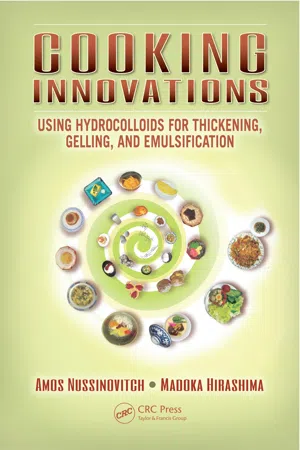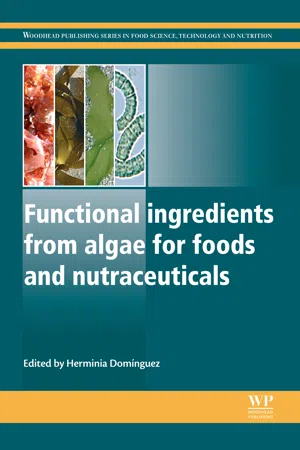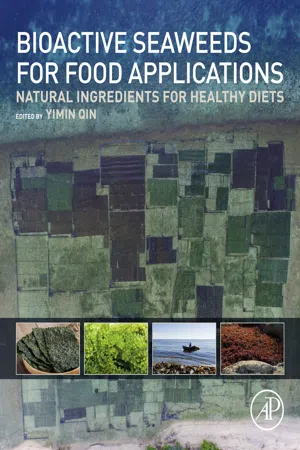Biological Sciences
Agar
Agar is a gelatinous substance derived from seaweed and is commonly used as a culture medium in microbiology to grow bacteria and other microorganisms. It provides a solid surface for microbial growth and is also used in food production as a thickening agent. Agar is heat stable, allowing it to be sterilized and poured into petri dishes for laboratory use.
Written by Perlego with AI-assistance
Related key terms
1 of 5
10 Key excerpts on "Agar"
- eBook - PDF
Cooking Innovations
Using Hydrocolloids for Thickening, Gelling, and Emulsification
- Amos Nussinovitch, Madoka Hirashima(Authors)
- 2013(Publication Date)
- CRC Press(Publisher)
1 © 2011 Taylor & Francis Group, LLC 2 Agar–Agar Historical Background Agar–Agar, more commonly referred to as, simply, Agar , was the first phycocolloid to be used as a food additive. Phycocolloids, that is, Agar, alginates ( Chapter 3 ), and carrageenans ( Chapter 4 ), are defined as gelling agents extracted from marine algae, which are traded and utilized in many ways exclusively for their colloidal character-istics. Agar was discovered in Japan in the mid-17th century; Tarozaemon Minoya is most commonly credited with this discovery, in 1658. Kanten , the Japanese term for Agar, means “cold sky,” and relates to the cold weather conditions in the mountains where it was produced. From Japan, its use as a food was introduced to natives in the Far East by Chinese settlers (Buddhist priests). In the coastal areas of Japan, use of a variety of Agar-gel-like seaweed extracts almost undoubtedly dates back to prehistoric times. The use of Agar for the manufacture of fruit and vegetable jellies was introduced to Europe by Dutch people living in Indonesia. In 1882, Robert Koch initiated the use of Agar as a culture medium and it remains the main bacteriological medium in use today. Collection and Processing of Seaweed for Agar Japan and Spain currently manufacture ~70% of the world supply of Agar. Gelidium is one of the algal sources for the traditional production of Agar in Japan, with as many as 24 local species. Another source is algae of the genus Gracilaria . In Japan, seaweed is gathered by divers equipped only with masks at water depths of up to ~9 m, or at below 18 m by divers equipped with diving gear. The seaweed is collected, stored in tubs or rafts, and towed to shore, where it is dried and partially bleached, then taken for final processing. Deepwater seaweed is regarded as yielding the best gelling extracts, and the most favorable harvesting period is April to September. - eBook - ePub
Industrial Gums
Polysaccharides and Their Derivatives
- James N. BeMiller, Roy L. Whistler(Authors)
- 2012(Publication Date)
- Academic Press(Publisher)
Official U.S. Specifications Specifications of Purity Structure ApplicationsMicrobiology Impression Materials Foods Medicine and Pharmaceuticals LaboratoryPropertiesSolubility Viscosity Gelation Temperature Coagulants Nonacidic Depolymerization GelsReferencesINTRODUCTION
According to the U.S. Pharmacopeia,1 Agar is a hydrophilic colloid extracted from certain marine algae of the class Rhodophyceae. Agar is insoluble in cold water but soluble in boiling water. A 1.5% solution is clear and when cooled at 32–39° forms a firm, resilient gel that does not melt below 85°. Other gums resembling Agar but not meeting all the specifications of this definition are termed Agaroids.Legend has it that in about 1660, Minoya Tarozaemon,2 a Japanese innkeeper, threw some surplus seaweed jelly into the winter night, expecting it to thaw in the morning sun and to disappear into the soil. He found, however, after several days of alternate freezing and thawing, a porous mass that could be reboiled in water and cooled to yield a gel equal to the original. He had discovered Agar. At Shimizu-mura, Japan, a monument2 commemorates the first commercial manufacture of Agar by a relative of Tarozaemon, Miyata Hanbei of Aza Shiroyama. In 1933, John Becker3 established the first of a series of Agar companies in San Diego, California, where production continues.SOURCE
Agar is obtained from various genera and species of the red-purple seaweeds, class Rhodophyceae, where it occurs as a structural carbohydrate in the cell walls and probably also performs a function in ion-exchange and dialysis processes.Species, Habitat, and Commercial Importance
Agarophytes of major commercial value are listed in Table 1 - eBook - ePub
- Glyn O. Phillips, Peter A. Williams(Authors)
- 2009(Publication Date)
- Woodhead Publishing(Publisher)
4Agar
R. Armisén; F. Gaiatas HispanAgar S. A., SpainAbstract
Agar has its origins in Japan in 1658. It was introduced first in the Far East and later in the rest of Agarophyte seaweed producing countries. Its use was introduced in Europe in 1859 and it was being used in bacteriological culture media in 1882. This chapter discusses the seaweeds used the world over as raw material for Agar production (Agarophyte seaweeds), and presents the industrial processes used for Agar production. The chemical structure of Agar and its fractions, such as Agaroses and Agaropectines, are presented, and the relation between its chemical structures and properties are also shown. The gelation and melting of Agar and its fractions, such as Agaroses and Agaropectines, is based only in the formation of hydrogen bridges (physical gels), and thus gelation is extraordinarily reversible. The synergies and antagonisms among Agar and other products in the gelation processes are studied. Various applications of Agar are presented, in some of which Agar is irreplaceable. Use formulations are shown in food preparations. Diverse applications are also presented, in the preparation of food for insects, for plant tissue culture, and in the preparation of culture media for microorganisms, as well as gels for denture moulding, the reproduction of archaeological remains or of fingerprinting in police work. Agar gels are important in food preparations with high content in soluble gross fibre, as Agar is the food additive with the highest content in said fibre, superior to that of 94%. Lately the production of more easily soluble Agars in water at temperatures below boiling point has been initiated, which proves to have noteworthy advantages for some of its applications. A comparative study is presented among the commercial products existing in the world market. - eBook - PDF
- Alistair M. Stephen, Glyn O. Phillips(Authors)
- 2016(Publication Date)
- CRC Press(Publisher)
230 References .......................................................................................................................... 230 7.1 OCCURRENCE AND BIOLOGICAL FUNCTION The word ‘‘Agar’’ refers to members of a class of galactan polysaccharides that occur as intercellular matrix material in numerous species of red seaweeds (marine algae of the class Rhodophyta). They serve a function in the structure of the plant analogous to, but differing from, that of cellulose in land plants. Whereas land plants require a rigid structure capable of withstanding the constant pull of gravity, marine plants need a more flexible structure to accommodate the varying stresses of currents and wave motion. They have adapted accord-ingly by developing hydrophilic, gelatinous structural materials that have the necessary pliability. Humankind, with its aptitude for turning nature’s inventions to its own purposes, has put Agars to use as gelling agents in a host of food and industrial applications, an activity that goes back 350 years and continues to this day [1–3a]. Agar-yielding species (Agarophytes) are found in the families Gracilariaceae, Gelidiaceae, Phyllophoraceae, and Ceramiaceae. Table 7.1 lists Agarophytes of commercial importance. Agarophytes are usually harvested from wild growth. Although mariculture of carrageeno-phytes (particularly Eucheuma spp.) has achieved substantial commercial importance, this has not been the case for Agarophytes. Only Chile has succeeded in commercial cultivation of an Agarophyte [4]. Environmental factors, particularly water temperature, are critical to successful transplantation and cultivation [5]. 217 - eBook - PDF
- Roy E. Martin, Emily Paine Carter, Jr., George J. Flick, Lynn M. Davis, Roy E. Martin, Emily Paine Carter, Jr., George J. Flick, Lynn M. Davis(Authors)
- 2000(Publication Date)
- CRC Press(Publisher)
Agar and Agarose form strong gels, with Agar gels being more elastic and less firm than Agarose gels. Gel strength is normally measured as resis- tance against a plunger on a 1.5 percent solution at 20°C and is in the range of 200 to more than 1,000 grams per cm2. As Agar is nearly neutrally charged, it does not react strongly with proteins or other charged molecules. A new Agar type called quick-soluble Agar has recently been developed, with the characteristic that it dissolves at lower temperatures than ordi- nary Agar. This product is obtained by drying the Agar directly from a solution instead of making the Agar gel before drying (Lebbar, 1992). USES 1. Agar is separated into,food-grade Agar and bacteriological grade Agar. 2. Food-grade Agar is used as a stabilizer in many foods such as canned meat, confectionary, and glazing/icing for the baking industry. 3. Bacteriological-grade Agar is used for stabili- zation of media for bacteriological growth. It can also be used for immobilization and encapsulation, as ions and nutrients easily diffuse through the gel (Jensen, 1990). 4. Agarose is mainly used in the pharmaceutical industry, where it can be used for separation and purification of proteins such as enzymes. These proteins can be made to travel through an Agarose gel because they are charged differently and have different sizes, and by different speeds they become separated. REFERENCES Abbott, I. A. 1988. Food and food products from seaweeds. In Algae and Hurnan Afiairs. C.A. Lembi, J . R. Waaland (eds.), pp. 136-146. Cambridge University Press, New York. Abbott, I. A. (ed.). 1994. Taxonomy of Economic Seaweeds. With reference to some Pacific species. In California Sea Cratzt College. Vol. IV, pp. 81-83. Armisen, R. and F. Galatas. (1987). Production, Properties and Uses of Agar. D.J. McHugh (ed.). University of New South Wales. Australian Defense Force Academy. Campbell, ACT 2600, Australia. FAO Fisheries Technical Paper 288. - Herminia Dominguez(Author)
- 2013(Publication Date)
- Woodhead Publishing(Publisher)
Murano, 1995 ).Agar is employed as a vegetarian gelatin with high fiber content, and is also used as a replacement in icings, glazes, processed cheeses and sweets. The use of Agar in food applications is based on its ability to form gels, and the unique properties of these gels. Agar dissolves in boiling water and, when cooled, forms a thermoreversible, clear, colorless and odorless gel. In contrast to gelatin gels that melt around 37 °C, Agar gels do not melt until heated to 85 °C or higher. The large difference between the gelling and melting temperatures (temperature hysteresis) is unusual, and unique to Agar. In spite of Agar having a very similar structure to carrageenan, it melts and gels at higher temperatures, and many of its applications take advantage of this difference. As an example, Agar is found to have specific uses in pastry fillings and glazes, which can be applied before the pastry is baked without melting in the oven. The Agar consumption for this segment of the market was 6050 tons during 2009 (Bixler and Porse, 2011 ). The same authors highlight the fact that although in processed meats carrageenan is the preferred water binder or texturing agent of choice, Agar holds on to the gelatin replacement market in canned meats and aspics, with a market of 150 tons during 2009. The texture of Agar in fruit jellies also helps it compete with kappa-carrageenan jellies, and the Agar texture is preferred in Asia, particularly in Japan, where Agar is a traditional ingredient which has been in use for hundreds of years. In the modern day it is one of the hydrocolloids that is available in many Asian grocery stores, and is sold as strips, in square form and more recently in tablet form. In western countries Agar is sold through specialized stores as a ‘natural food and functional seaweed product’ with a market of 2000 tons in 2009 (Bixler and Porse, 2011- eBook - PDF
- Sakhare, Vishwas B(Authors)
- 2021(Publication Date)
- Daya Publishing House(Publisher)
Once again, research into life cycles has led to the development of cultivation industries that now supply a high proportion of the raw material for some hydrocolloids. Today, approximately 1 million tonnes of wet seaweed are harvested and extracted to produce the above three hydrocolloids. Total hydrocolloid production is about 55 000 tonnes, with a value of US$ 585 million. Alginate production (US$ 213 million) is by extraction from brown seaweeds, all of which are harvested from the wild; cultivation of brown seaweeds is too expensive to provide raw material for industrial uses. Agar production (US$ 132 million) is principally from two types of red seaweed, one of which has been cultivated since the 1960-70s, but on a much larger scale since 1990, and this has allowed the expansion of the Agar industry. Industrial Uses of Seaweeds Agar-Agar Agar is the major constituent of the cell walls of certain red algae, This ebook is exclusively for this university only. Cannot be resold/distributed. especially members of the Gelidiaceae and Gracilariaceae. Agar is the Malay world for the gelling substance extracted from Eucheuma, but now know to be a carrageenan. The term Agar is now generally applied to those algal galactans which have Agarose, the disaccharide Agarobiose, as their repeating unit. A family of molecules varying amounts of Agarose and Agaropectin forming the polymers has been described by various investigators (Araki 1978; Duckworth et al., 1971; Izumi 1971 and 1973; Rees 1972; Craigie and Leigh 1978). Agar is soluble in and extracted by hot water; it gels at room temperature and freezing and thawing are used to purify it. The best known use of Agar is as a solidifying agent in culture media in bacteriology. Two genera, Gelidium and Gracilaria, account for most of the raw material used for the extraction of Agar. - Khuntia, B K(Authors)
- 2021(Publication Date)
- Daya Publishing House(Publisher)
2. Solid Media This ebook is exclusively for this university only. Cannot be resold/distributed. These are solidified substances, in which liquid broths have been supplemented with a solidifying agent called ‘Agar’, at a level more than 1%. Agar is a powder (sometimes called Agar Agar) extracted from seaweeds and is a complex carbohydrate composed mainly of galactose. It is important to note that, Agar is a solidifying agent and has no nutritional value for bacteria. It serves as an excellent solidifying agent, as in aqueous solution it liquefies at 100°C and solidifies at 40°C. Most of the pathogenic bacteria of human are grown at 37°C (normal human body temperature). Agar does not melt at this temperature and provides a hard surface. On this nutritionally rich hard surface, each single bacterium grows, multiplies and gives rise to an isolated colony of that bacteria. Such isolation is not possible in liquid media, where bacteria grow in suspension. Solid Agar media can be prepared in the following forms. ( a ) Agar Plates Agar powder, at a level of more than 1%, is dissolved completely in liquid broth by warming. Then, it is sterilised in an autoclave. It remains liquid in hot condition and solidifies as it cools. In the warm liquid state, it is poured into sterilised petri dishes (20 ml in each petri dish) and allowed to cool, so that it forms a thick layer at the bottom of the petri dishes. These petri dishes containing a thick layer of solidified Agar media are called ‘Agar plates’ or simply ‘plates’. Bacteria are grown as isolated colonies on these plates for their enumeration and isolation. The characteristics of these colonies also help in the identification of bacteria. Petri dishes are available in different sizes to meet different experimental conditions. For routine purposes, however, petri dishes of 15 cm diameter are used.- eBook - PDF
Industrial Gums
Polysaccharides and Their Derivatives
- Roy Whistler(Author)
- 2012(Publication Date)
- Academic Press(Publisher)
Agar, and particularly Agarose, are now used in differentiating proteins, lipo-proteins, enzymes, and other high-molecular-weight compounds by electrophore-sis, gel-bead filtration, and gel chromatography. 4. Derivatives Fairbrother and Mastin 26 found that the calcium of native Agar could be re-placed by other cations. Hoffman and Gortner 27 showed Agar to behave like a salt of a highly ionized acid capable of salt formation by neutralization with bases. Other exchanges 28 and derivatives, such as the acetate 29 ' 30 and methyl ether 30 were soon investigated. Partial precipitation of Agar by quaternary am-monium compounds was found to be a useful separation method. 31 A method of obtaining Agarose (Agaran) by precipitation of Agaropectin by a quaternary ammonium salt and its separation from Agarose by centrifugation became generally useful. 32 ' 3 3 Interest in this fraction is increasing, and other Agarose separation methods based on poly (ethylene glycol), 34 enzymes and sequestrants, 35 ammonium sulfate, 36 aluminum chloride, 37 methyl sulfoxide, 38 EDTA and aluminum hydroxide, 39 and buffer extraction or electrophoretic puri-fication followed by anion-exchange 40 have been devised. 40 H. H. SELBY AND W. H. WYNNE For making sodium Agarose, sodium iodide has been found to have certain advantages. 41 V. PRESENT APPLICATIONS Microbiology. —Agar is most valuable in microbiology, although outside the United States larger quantities are used in other applications. The ideal Agar is low in metabolizable or inhibitory substances, debris, and thermoduric spores; has a gelation temperature of 3 5 ° -4 0 ° and a gel-melting temperature of 7 5 ° -8 5 ° ; is readily soluble, and has good gel firmness, resil-ience, clarity, and stability. Agar concentrations of 1 -2 % are commonly used for this purpose. In low concentrations, Agar prevents the entry of oxygen into liquid media, making the cultivation of anaerobes feasible in air-exposed broths. - eBook - ePub
Bioactive Seaweeds for Food Applications
Natural Ingredients for Healthy Diets
- Yimin Qin(Author)
- 2018(Publication Date)
- Academic Press(Publisher)
- • Agar is also used on a large scale in canned products such as “scatola” meat (beef blocks in gelatine) that is very popular in Italy, chicken in gelatine that is very common in Canada, cow tongue in gelatine that sells well in Denmark, lamb tongue in Australia, or other different types of meat and fish aspics. In dressings and extracts it is used as a thickener and stabilizer;
Because Agar gels can hold large amounts of soluble solids such as sugar without allowing crystallization, becoming opaque, or losing adhesive properties, they are used widely in the preparation of bakery glazes, icings, toppings, etc. For the same reasons, they are also effective in the formulation of good-quality piping jellies for fillings in doughnuts, filled cakes, etc. Agar gels can withstand autoclaving temperatures without breaking down or disintegrating and therefore are used in many canned meat products in those countries where it is permitted, primarily in Europe and Japan. Jellied candy and various gelled confections in many countries have been made with Agar.Clear pasta noodles made from Agar plus starch and other additives are a popular product sold in Japan. Silkworm food is made from macerated mulberry leaves mixed with starch, fiber, vitamins, minerals, and Agar, which is heated and cooled to form a gelled slab that is finally shredded to give an extended, nutritious silkworm feed. Canned water-dessert jellies using Agar are also a very popular product sold in Japan (Glicksman, 1987 ).A fundamental characteristic of an Agar and Agarose gel is what can be called “gelation hysteresis.” An Agar or Agarose gel, when cooled, forms a gel at temperatures between 32 and 43°C depending on the seaweeds used, as that will determine the presence of a variable quantity of methyl groups. However, when the well-formed gel is heated, a temperature of 85°C must be reached to get the gel to melt and to become a solution. Such a big difference between gelling and melting temperatures is exceptional when compared with the other seaweed hydrocolloids. It is explained by a greater number of hydrogen bonds and the lack of sulfate groups, which produce a gel with helix pitches much shorter than those of carrageenans.The characteristic of “viscosity hysteresis” is also remarkable. This can be demonstrated by a solution or colloidal solution prepared at boiling point and held in a thermostatic bath, for example, at 80°C, and then its viscosity measured. Afterward it is held at a lower temperature, at 50°C, for example, keeping it there for a few hours. Subsequently, it is held again at 80°C, and once this temperature is reached its viscosity is determined again. For Agar, it gives values higher than those initially measured. When this temperature is maintained, viscosity values decline slowly almost down to the values measured the first time. Therefore the viscosity values obtained for a solution of Agar could depend on its previous history.
Index pages curate the most relevant extracts from our library of academic textbooks. They’ve been created using an in-house natural language model (NLM), each adding context and meaning to key research topics.









